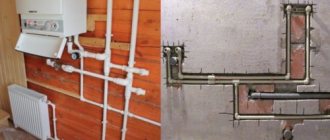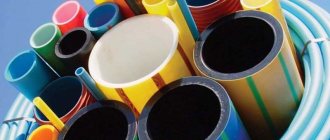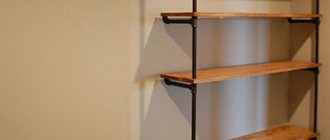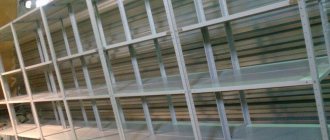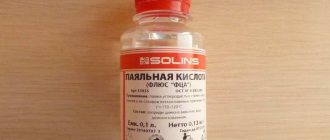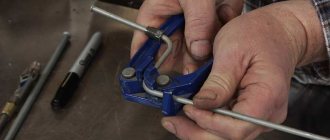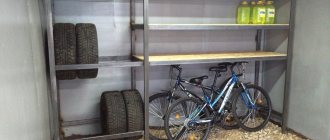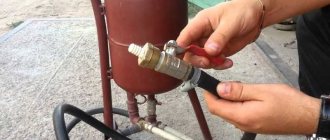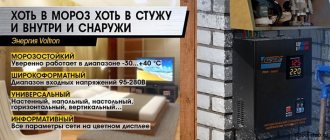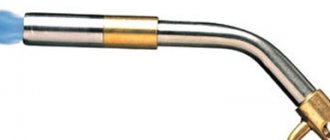Thermoplastic propylene polymers, compared to traditional polyethylene, have a lower density, as well as higher hardness, heat resistance and resistance to corrosive changes. Welding of polypropylene pipes ensures the most reliable connection of all elements into a single system. Such work must be carried out using special equipment, in strict adherence to technology. Let's take a closer look at the intricacies of soldering PPR pipes.
Types of polypropylene pipes
The service life of products depends on the temperature of the environment and the pressure created in them.
With the right choice of material type, it is possible to significantly extend its operational capabilities. There are 4 types of pipe materials that have different characteristics depending on their operating temperature.
| Product type and corresponding markings | Purpose | Ambient temperature, C | Working pressure, MPa |
| PN10 | For cold water supply and heated floors | 20 for cold water supply, 45 for floor heating system | 1 |
| PN16 | For cold and hot water supply | Up to 60 | 1,6 |
| PN20 | For hot water supply | Up to 80 | 2 |
| PN25 | For central heating systems, reinforced products, hot water systems | Up to 95 | 2,5 |
PN10 grade materials refer to products intended for cold water supply. They are not able to withstand high ambient temperatures. The second type, marked PN16, refers to mixed-type products and is intended for cold and hot water supply, but with limited operating temperature. PN20 and PN25 are materials intended for hot water supply. Such pipelines are able to withstand high temperatures, and products marked PN25 are additionally reinforced with metal, which increases their service life and ability to withstand high pressure and temperature conditions.
Pipe welding kit
If welding of polypropylene products has to be carried out regularly, then it is advisable to purchase a special welding kit, which is immediately sold in an appropriate suitcase. Its average cost is about one hundred dollars, and it consists of:
- heating element;
- Teflon nozzles of different sizes;
- scissors for cutting polypropylene pipes;
- bolts that secure the nozzle to the heating element;
- level;
- supports for the heating element;
- hexagon for tightening bolts.
In the case when welding work is carried out occasionally, it is more rational to rent welding equipment.
How long to heat
Before you start welding plastic lines, the welder must be placed in a convenient place and firmly strengthened. Then you can install the attachments. Only now can the equipment be connected to power. Next, the device should warm up. This will take about ten minutes.
When the desired temperature is reached, the indicator on the unit should go out. It thus signals that the device is ready for operation.
For a hot apparatus, it is recommended to equip a stand, because the master’s hands must be free to fasten the heated parts.
Types and purpose
Polypropylene pipes can be of four colors - green, gray, white and black. Only black ones differ in their characteristics - they have increased resistance to ultraviolet radiation and are used when laying an irrigation system on the ground. All others have similar characteristics and are laid indoors or buried in the ground.
According to their intended purpose, polypropylene pipes are of the following types:
- For cold water (temperature up to +45°C). They can be easily distinguished by their longitudinal blue stripe.
- For hot water supply (heating up to +85°C). A distinctive feature is a red stripe.
- Universal (maximum heating up to +65-75°C depending on the manufacturer). Two stripes are applied side by side - blue and red.
There are pipes with different characteristics for both cold and hot water. This is displayed in the markings:
- PN10 are used exclusively in cold water supply systems (up to +45°C) with low pressure (up to 1 MPa). They have small wall thickness. Not suitable for high-rise buildings.
- PN16. They are often labeled as universal, but are more often used for cold water - they can withstand heating of the environment up to +65°C and pressure up to 1.6 MPa.
- PN20. Thick-walled pipes, which can transport media with temperatures up to +80°C, can withstand pressures of up to 2 MPa. Used for distributing hot water and heating systems.
- PN25. These are reinforced polypropylene pipes (with foil or fiberglass). Due to the presence of a reinforcing layer, they often have a smaller wall thickness than PN20. The heating temperature of the medium is up to +95°C, pressure is up to 2.5 MPa. Used for hot water supply and heating.
All of them are produced in different diameters - up to 600 mm, but in apartments and private houses they are used mainly in sizes from 16 mm to 110 mm
Please note that the internal diameter is indicated, as wall thickness may vary.
How to properly solder polypropylene - instructions
You need to act consistently, in this case the likelihood that a mistake will be made is reduced.
Step-by-step instructions for soldering polypropylene pipes Soldering instructions:
- Preparing the room. Considering that toxic substances are released during soldering, effective air circulation should be ensured.
- After cutting, the edges of the communications are processed with a trimmer or chamfer. They make chamfers, this makes it easier to join the pipes.
- The materials are degreased: cleaned of dust, treated with white spirit. You need to continue working when the surface is completely dry.
- Turn on the soldering iron, having previously set the temperature to the required level (+260°C).
- When the green light on the body of the soldering iron lights up, you can proceed to soldering. A pipe is installed in the sleeve nozzle, and a fitting is placed on the mandrel.
- At the same time, 2 elements of the future pipeline are heated: a fitting, a pipe.
- After waiting the time indicated in the table above, the pipe and the shaped element are removed from the nozzles and joined to each other. In this case, the parts must be held motionless. Communications are connected to a previously drawn longitudinal line. The slightest displacement of polypropylene that has not yet hardened will lead to the destruction of molecular bonds. This may cause a leak in the future.
Soldering table for polypropylene pipes
| Pipe diameter, mm | Length of the section that is heated, mm | Soldering period duration, seconds | ||
| Holding the pipe in the soldering iron nozzle | When connecting pipeline sections | When polypropylene hardens | ||
| 16 | 12 | 4-5 | 4 | 120 |
| 20 | 14 | 5 | ||
| 25 | 15 | 6-7 | 6 | |
| 32 | 16 | 8 | 240 | |
| 40 | 18 | 10-12 | ||
| 50 | 20 | 18 | ||
The heating and holding time of PP pipes at a given soldering iron temperature allows us to ensure high quality seam joints. Low heating will not allow softening of communications. In this case, it will be impossible to join the pipes.
Connecting pipes by soldering with reinforcement
The operating temperature of communications for cold water supply varies within -10…+90°C. Under the influence of the coolant, the pipeline bends, as intense linear expansion occurs. This means that for heating you need to use pipes that have more suitable characteristics.
1 - cut off the required length of pipe. 2 - remove the reinforcement with a seamstress. 3 - direction marking. 4 - heating of the pipe and fitting. 5, 6 - connecting the pipe with the fitting and fixing it.
Thus, in conditions of exposure to high temperatures, products reinforced with fiberglass or aluminum are used. Such pipes are multilayer products: a thin layer of fiberglass is applied on top of the polymer product and covered with a layer of PP. Advantages:
- relative stability of linear expansion, even under the influence of high temperatures the geometry of the product changes slightly;
- ability to withstand pressure up to 10 atm; for comparison, in apartment buildings, communications are subject to less intense influence (6-8 atm);
- due to the presence of a reinforcement layer, the service life of the pipeline increases;
- pipes with internal reinforcement are resistant to high temperatures, at which the classic version of communications begins to melt.
The technology for soldering reinforced pipes does not differ from the method of joining unreinforced communications, with the only exception: at the preparatory stage, the ends of the products must be cleaned of the reinforcing layer, for which a trimmer or shaver is used. After preparation, the pipes are degreased, then heated with a soldering iron and connected.
Rules for soldering PCB to avoid mistakes
- The diameter of the polypropylene pipe is selected according to the size table;
- before work, prepare everything necessary, since welding is performed quickly, there will be no time for preparation during the installation process, the soldering iron is turned on when the communications are already cut;
- the welding machine must be securely fixed on a horizontal surface, the quality of the seam will depend on this, such units are equipped with special stands, but some models are not installed firmly, so they need to be additionally secured;
- the melting temperature of polypropylene is much lower than the value set in the welding machine settings, this difference is due to the need to quickly soften the pipe; a temperature of +260°C is considered sufficient;
- You should not change the temperature regime when using larger products, when soldering PP pipes, the heating temperature does not change with increasing diameter of communications, from the table above you can find out that the dimensions of the products only determine the duration of heating of the material;
- you need to navigate by the indication: a red light indicates that the heating element has turned on, a green light indicates that the set temperature value has been reached;
- Often users skip the stage of degreasing the material, however, the presence of dust or drops of water in the cut area can cause the seam to weaken, since in this case the structure of the material becomes more porous;
- when installing a pipeline of complex configuration, it is necessary to connect the pipes at different angles, they are also rotated relative to each other; in order not to disturb the alignment of the products, it is recommended to first determine the exact position of the communications, then perform their preliminary installation (without using a soldering iron), at this stage you need to draw a marking strip along the center line through the 2 parts being connected.
It should be taken into account that thin-walled pipes warm up faster. This means that the period of operation of the soldering iron is reduced by 2 times. If you are studying the question at what temperature to solder such pipes, you need to remember that the value of this parameter does not depend on the dimensions of the product. Thin-walled communications are connected to each other at the same temperature as thick-walled ones.
Impact of errors on welding quality
This is what happens if you solder PP pipes incorrectly!
The most common violations of the soldering process:
- surfaces are not degreased, resulting in a decrease in the quality of the seam joint;
- The cut angle of the pipe and fitting does not correspond to 90°;
- insufficient deepening of the pipe into the fitting or, conversely, communications are brought into the shaped element all the way, as a result, a large seam is formed inside, which impedes the flow of liquid;
- violation of the heating technology: the pipes were on the nozzles for too little or, conversely, a lot of time, in both cases the quality of the seam joint will be low;
- when connecting reinforced pipes, the reinforcement layer at the end section was not completely removed, as a result, this material will prevent the melting of polypropylene, such a seam will be weak, or it will not be possible to complete it at all;
- after joining, the position of the parts was adjusted, which led to a decrease in the reliability of the seam; To avoid such consequences, you should wait a while after connecting the pipe and fitting, ensuring that the parts do not move.
How to solder PP pipes without a soldering iron
When considering methods for welding polypropylene pipes, it is not always possible to use a special soldering iron. In this case, choose other options, among them:
- gas-burner;
- compression coupling;
- cold welding.
The gas burner method is less preferable.
If a torch is used, it will not be possible to heat the polypropylene evenly. As a result, the seam joint will look sloppy, in which case the reliability of the seam is reduced. Over time, a leak may appear in this area. This method can be used as a last resort and only when installing cold water supply systems.
Connecting a pp pipe with a compression coupling
The compression coupling provides a reliable connection of communications and is used as a complete replacement for a welding machine. However, the cost of such an element is high. As a result, costs will increase, since a large number of compression fittings will be needed to distribute pipes throughout the room.
Method for gluing polypropylene pipes.
The cold welding method is also effective. In this case, a two-component epoxy composition is used. This material allows you to obtain a reliable connection without special equipment.
To fix the communications, you need to apply an adhesive substance to the cleaned and degreased surfaces of the products. Then the pipe and fitting are joined, holding tightly. The glue sets within 10 minutes. It takes 1 hour to completely harden. This option can only be used when installing a cold water supply system.
Stage two. Welding of polypropylene pipes
This procedure will require an electric jigsaw (cutting polypropylene) and special welding equipment.
Step one. While the apparatus is warming up, the necessary measurements are taken, the pipes are marked and cut.
Step two. The ends of the products that are planned to be connected to each other are thoroughly cleaned and degreased.
Step three. Using a pencil, mark the depth of insertion of each product into the sleeve. It is typical that at least a millimeter gap should remain, so the pipes do not rest against the fitting coupling.
Step four. The PP pipe with fitting is put on the sleeve in accordance with the marks made, and heating of all elements must occur simultaneously.
The heating duration depends not only on the diameter of the products, but also on the depth of welding (this can be found in the table below).
Step five. After a certain period of time, the products are removed and connected, pressing onto each other with little effort. It is prohibited to rotate the elements along the center line.
Step six. Within a few seconds after the connection, an initial adjustment is made, then the elements are finally fixed.
If there are no gaps left at the connection point, then it (the connection) can be considered high quality.
Manufacturing of welding machine
Due to the fact that a more or less good one costs over a thousand rubles, it is cheaper to rent it or make it yourself. If the latter was chosen, then for work you should prepare:
The sequence of actions should be as follows.
Step one. In order to improve heat transfer, the sole of the iron is treated with thermal paste, then a Teflon sleeve is fixed. The location of the latter is determined in advance - the wide part up or down.
Step two. The sharp “nose” is filed off for more convenient work near walls.
Step three. The iron is heated until the device turns off a second time.
Step four. It’s good if the iron is equipped with a temperature sensor - this will allow you to accurately determine the heating temperature. But there is an easier way - through lead. This metal melts at 230ᵒC and above, which approximately coincides with the temperature required for welding.
The further technology is identical to that described above.
Methods for joining PE pipes
Polyethylene pipelines are installed in two ways: using fittings and flanges or several types of welding.
The connection requires special fittings (couplings and sockets) and without them. For pipes with a wall thickness less than 4.5 (diameters 50-110 mm), welding using fittings is used; for larger pipes with a thicker wall, butt welding and extruder welding are acceptable.
Diffusion
The diffusion method involves heating the ends to a viscous flow state. The prepared ends of the workpieces are joined and slightly compressed. Movable polymer molecules, under the influence of pressure, move into the parts being connected, mix, freeze in a new position when cooled, form new chemical bonds and ensure reliable adhesion of the pipes to each other.
It is incorrect to single out any welding method as diffusion. In fact, any welding of polyethylene is based on the process of diffusion of heated molecules.
Bell method
Not the most typical way. There are two options for implementation: using socket pipes and couplings. The method itself is reminiscent of welding polypropylene pipelines: the socket or coupling and the workpiece are heated using a soldering iron with a special nozzle. Then the workpiece is inserted into the socket of another pipe or coupling, fixed, pressed and held. Welding time – 20 seconds. If couplings are used, then the second pipe is soldered into the coupling in the same way. The cost of couplings is low; products with a socket are rarely found in stores. The connection is reliable and durable; small diameters can be welded.
Butt welding
This method is applicable to pipes with a wall thickness of more than 4.5–5 mm and a diameter of more than 50 mm.
Before carrying out work, cut off the polyethylene pipe strictly perpendicularly and thoroughly clean the ends. Then fix the pipe in the welding machine and carefully center it. A heater is inserted between the ends of the heating pipes, the pipes are pressed against it and heated until the ends soften. Then the heater is quickly removed, the ends are compressed in such a way that a small annular bead is formed at the junction - a flash. Cool the joint, then remove the machine. The work has its own subtleties; it requires two people.
Extruder welding
Extrusion - welding using a small apparatus from which molten polyethylene is extruded under pressure. Raw materials in the form of rods or granules are loaded into the extruder. Extrusion is used on pressure communications with a wall thickness of more than 6 mm, but it can also be used to patch non-pressure sewer pipelines with a thinner wall. The connection point is heated by a stream of hot air. It is advisable to chamfer the ends.
The quality of the seam is very high. The advantage of the method is that it is possible to weld an already laid polyethylene pipe without dismantling the pipeline.
Electrofusion welding
This is the most reliable, convenient and universal connection method. It can be used even in hard-to-reach places. But, unfortunately, it is also the most expensive - electric welding fittings are not cheap, and a welding machine also costs a lot. Welding with thermistor couplings is used from small to large diameter polyethylene pipelines.
During thermistor welding, polyethylene blanks are cut strictly perpendicular, carefully cleaned of burrs and dust, inserted into the coupling, and centered using special devices. The coupling has a heating element. It is connected to a special welding machine, current is supplied, the element heats up the coupling and the ends of the pipes, and they are welded.
With this type of welding, it is extremely important to keep the joint motionless until it cools completely.
Which way is better
Before choosing the best connection method, it is necessary to determine which one is applicable in a particular case, depending on the diameter of the pipeline.
The most reliable and universal method is welding using thermistor couplings. But couplings, especially large diameters, are expensive, expensive, and a welding machine (but you can rent one). Therefore, such welding is not very common when arranging a private home.
More often they are butt welded or using solder couplings. Butt welding is used on polyethylene pipes with large wall thicknesses; these are usually not used in private homes. Extrusion welding is not yet very widespread, mainly due to the little known nature of the method.
Required Tools
Fitting;
The polypropylene pipes themselves;
A special apparatus for welding such pipes;
Welding machine
A hacksaw for cutting them, a special cutter is often sold complete with a welding machine; for large volumes of work, you can use a ring cutter or special scissors;
Degreaser (ethyl or isobutyl alcohol); It is prohibited to use acetone in this case, as it can soften the plastic;
Chamfer: its internal part resembles a pencil sharpener, however, since the chamfer must be removed smoothly, the knives are located at a different angle; You can replace the bevel remover with a regular file and knife;
Beveler for plastic pipes
Shaver: a tool for removing the reinforced layer (if our pipes have a reinforcement layer).
Shaver
Advice.
Pipes that come close to the heating boiler (at a distance closer than half a meter) should be made only of metal. They are connected to polypropylene using adapters from a welded connection to a threaded one.
Preparing pipes for welding
The edge of the pipe is cut with special scissors at a right angle. The cut area is sanded and degreased with ethyl alcohol or soap solution. The surface is thoroughly dried. Products marked PN 10-20 are welded immediately, and those with PN 25 are additionally cleaned with a shaver, removing part of the polypropylene and aluminum to the soldering depth. They are oriented according to the size of the nozzle up to the limiter.
Important! For degreasing, it is prohibited to use any solvents, gasoline, vodka, or acetone. Aggressive liquids corrode the surface of polypropylene.
When using a socket connection, it is important to adhere to the stripping depth and chamfer width. The degree of stripping must match the depth of installation of the elements.
Table for stripping pipes of different diameters
Working with polypropylene pipes
Today's polypropylene pipe installation system includes all the necessary elements for connecting pipes of all sizes, contours, fittings, fastenings and inclusions. The assembly process is quite simple and, if you have the necessary skills, happens quickly.
The set of elements can be selected the way you want, so the result is a completely unique system. The complexity and configuration depends only on the preferences and wishes of the customer, that is, you. The only feature that some attribute to the disadvantages of polypropylene is the welded connection method. After welding, it is no longer possible to separate the pipes and correct the error. Therefore, you need to think through everything in advance and try to avoid inaccuracies in actions.
If you break down the pipe welding process into separate steps, it will look like this:
- Using a soldering iron for polypropylene, you need to heat both parts that you want to attach to each other.
- Then you need to connect the heated parts;
- After a short period of time, remove the elements already fastened together from the device.
Welding provides the elements with such a strong connection that it is almost impossible to separate the parts without breaking them. That is why polypropylene pipes are considered high quality, durable and able to withstand almost any pressure.
Main stages of work
1. Take a pipe of the required size.
2. We clean its edges from burrs formed during cutting with a file or chamfer.
3. With a pencil, mark at the end of the pipe (see photo) which section we need to melt, that is, we mark the place where the fitting will be put on.
We mark the place of adhesion with a pencil
4. Treat the pipe and fitting with a degreasing compound.
5. Firmly fix the welding machine to the table.
6. Its kit includes nozzles of different diameters. We take the required nozzles (one for the fitting and one for the pipe) and attach them to both sides of the device.
7. Set the temperature to 260°.
8. As soon as the lights go out (this means that the device is warm enough), you can start working. The average heating time is 2-3 minutes.
9. We put a fitting and a pipe on the hot nozzles (there are two of them) up to the pencil mark. Do not put too much pressure on the parts to be welded or rotate them.
Butt welding machine. The fitting and pipe are put on the hot nozzles
10. We count down the required amount of time. The heating time is always indicated in the instructions. For example, for a 25 mm pipe it is exactly 7 seconds).
The heating time of the device depends on the diameter of the pipe
11. Quickly and carefully remove the heated parts, slightly holding the welding machine.
12. Connect them with each other. Excessive pressure on them or rotation is also unacceptable.
13. We wait a few seconds.
14. If we did everything correctly, we get a perfectly smooth, homogeneous connection.
The reinforced layer on a section of the connection must be removed, otherwise the connection will be heterogeneous and fragile;
When purchasing a device, it is not necessary to spend extra money and purchase a model with a thermostat, because we will need only one temperature setting of 260°C; using other modes may result in a poor connection;
Water must flow through the pipes freely; To prevent an obstacle in the form of frozen plastic from forming at the welding site, you should not put too much pressure on the molten parts when joining; however, weak pressure is also unacceptable - the length of the connection for reliable fastening will not be enough; this can lead to the formation of vortex and pressure drop in the system;
The basic rule for such soldering is that the fitting is put on the nozzle first, and only then the pipe; The countdown begins when both parts are on the device;
Polypropylene sets in 4-8 seconds, but you shouldn’t let it go right away - for it to completely harden, you need to wait 20-30 seconds;
When cooling, the parts must remain motionless; the slightest shift can break the tightness of the connection; therefore, before starting soldering, it is better to prepare special clamps for fixing them; they can be made from any block of wood or strong wire;
Cooling the resulting assembly with water or a stream of cold air is prohibited - the connection will be fragile;
Do not heat the pipe and fitting for more than the prescribed time - the polypropylene will be deformed; with less time for heating, the connection of parts will be difficult;
If welded correctly, part of the plastic should form a slight overhang on the coupling;
You can check the quality of your work by cutting the connected section in half; you should see an even monolithic connection without deformations or voids at the junction.
Soldering methods
In practice today, a couple of basic methods are used to ensure durable and reliable joining of welded elements:
- coupling;
- straight.
The first option is welding polypropylene pipelines using a shaped product (coupling) or a pipe having a sufficient external size. This method is suitable for plastic pipelines of small diameter. It consists of melting the outer side of the elements and the inner part of the coupling, which ensures a guaranteed tight joint.
Direct welding involves melting the end part of plastic pipes with the same diameter, as well as their subsequent joining with the end surfaces. A special feature of the method is the need to perform welding with extreme precision in processing all abutting areas and connecting them to each other.
In addition to the “hot” technologies already listed above, you can use a fairly simple and affordable method of “cold” soldering of polypropylene. In this case, a replacement for the active soldering component is a special solvent that promotes rapid softening of the polypropylene structure.
Sewage system made of PP pipes
As noted earlier, polypropylene pipes are now actively used in the construction of buildings. The installation procedure in this case has its own nuances.
Internal sewerage
There are a number of rules that must be followed when installing sewerage in the house.
- The pipeline is laid at an angle in the direction of the sewer riser (about 3 cm per linear meter).
- If the room is not heated, then the pipes are additionally insulated with mineral wool.
- You cannot make sharp turns at an angle of 90ᵒ; instead, so-called half-bends are used.
- Fan-type ventilation is an essential component of the sewer system, which will prevent the penetration of unpleasant odors into the home.
- The toilet is connected only after the sink, otherwise the water seal will break.
External sewerage
Step one. The diameter of the pipes is determined, depending mainly on the number of people living in the house.
Step two. A trench is dug from the sewer riser to a septic tank or cesspool. In this case, a slope is maintained depending on the soil freezing line, or the pipeline is insulated with mineral wool.
Step three. The bottom is covered with a “cushion” of sand. Its thickness should be at least 20 cm.
Step four. Pipeline being laid
It is important to avoid possible sagging, otherwise the connections will soon collapse. Horizontal drilling of a trench for a pipeline is carried out using special equipment with pressure-action pump jacks
Drilling occurs using a steel cone-shaped tip. A similar technology is used in construction:
Horizontal drilling of a trench for a pipeline is carried out using special equipment with pressure-action pump jacks. Drilling occurs using a steel cone-shaped tip. A similar technology is used in construction:
- auto and railway roads;
- pipelines to basements;
- highways to working wells.
Installing a PP pipeline with your own hands will help you save a lot, but only if done correctly.
Products made from polypropylene are used, as a rule, when creating drainage and irrigation systems, as well as when laying water pipes or arranging a heating system. Polypropylene belongs to the class of polyolefins, which means that all products made from this material are characterized by a high degree of environmental safety.
In addition, drainage systems made of polypropylene can last a very long time, while the costs of their operation will be minimal. However, when working with such products, you need to know how to weld polypropylene pipes in such a way as to avoid their deformation
and prevent leaks.
Last stage: cooling and checking the tightness of the connection
Polymer pipes must cool in a natural environment. A forced decrease in the temperature of the material will lead to disruption of a number of processes in the structure of the material. First of all, the strength of the joint will be reduced. To check the tightness the following methods are used:
- perform purging;
- let water through.
INTERESTING: Do-it-yourself septic tank made of concrete rings for a private house
Then the permeability of communications is assessed. When a gap appears, water droplets will appear on the outside of the pipeline.
DIY welding
Work should be carried out in a room with good ventilation. When heated, polypropylene can release toxic substances, which can cause harm to health, causing poisoning.
Step-by-step welding instructions:
- First, install the required nozzle of the correct size on the soldering iron;
- To melt polypropylene, a temperature of 260 degrees must be reached;
- Prepare parts for connection, clean them and place them correctly;
- Then the soldering iron is put into operation;
- It is necessary to wait the required time for heating, and this is indicated by the green color of the sensor.
When soldering, it is better to place the device in such a way that it stands stable.
Then the pipe and fitting are simultaneously put on the blank and the soldering tool. The pipe is inserted inside the blank. The fitting is placed on the outside. It is pushed in all the way, and the pipe is pushed in to the finished mark. The main thing is to keep the timing right.
If the tool does not warm up well, then the level of diffusion will be low, and this will compromise the quality of the alloy. A high temperature will lead to overheating of parts. The optimal time depends on the diameter of the pipe and fittings.
After heating, it is important to immediately perform docking. The main rule of procedure is tolerability
The first few seconds allow you to make a correction, but making turns is prohibited. At the same time, you need to take your time and take your time, sticking to the golden mean.
Construction of houses
0 votes
+
Vote for!
—
Vote against!
Plastic pipes have long gained popularity in the construction markets, not least due to their low cost and simple assembly process of the finished structure, which allowed them to stand out among other options. Plastic pipes are reliable and durable, they are not afraid of rust and are lightweight - which, together with other advantages, has made them so popular. However, such pipes can also leak. This is mainly due to a violation of the pipe soldering process and errors made during this process. This, as well as the installation features, will be discussed further.
Table of contents
- Types of welding PVC pipes
- Welding equipment used
- How to weld PVC pipes
- Common mistakes when welding pipes
- Tips for welding pipes
Types of welding PVC pipes
At the moment, there are two ways to solder PVC pipes. Manual welding of pipes itself is technically simple, but even the preparatory work should be done carefully and carefully to avoid leaks in the future. Experts identify the following work methods:
- welding pipes using a special soldering iron and cutting scissors (this welding technology is used in many works and, in fact, is the most widespread),
- “cold” welding (this method is simpler and allows you to work without a soldering machine. To carry out pipe connection work, it is enough to work with aggressive glue for hard plastics).
The first two methods are primarily suitable for pipeline systems through which high-pressure water is not expected to flow. If it is supposed to supply water or for heating systems under pressure, then welding involves slightly different methods:
- sleeve welding. In this case, connecting elements (couplings, fittings, etc.) are additionally welded to the pipe.
- electrofusion welding. In this type of welding, the couplings contain special connecting elements, which melt when voltage is applied to them, ensuring reliable soldering to the pipe sections,
- butt welding. A fairly simple process in its essence, used for welding large-diameter pipes. In this case, the ends of the pipes are heated to the melting temperature (200-250 degrees) and simply connected to each other.
In fact, all the described methods are based on the same aspect: the PVC material, when exposed to high temperatures, melts and forms a reliable connection due to the mutual penetration of particles into each other.
Each method has its own advantages and disadvantages. Simple welding allows you to work with various types of plastic pipes, but requires some skill. The use of adhesive joints has high performance, almost as good as welding. But given the fact that polyvinyl chloride (PVC) pipes are not recommended for use for hot water (except for some varieties that can withstand high temperatures), this method of joining with glue is best used for communication systems that do not use high pressure.
Welding equipment used
Welding plastic pipes does not require a specific tool and allows you to carry out all the work alone. To do this, you will need cutting scissors (it is only important to first make sure on the unnecessary section how sharp they are to avoid possible deformation and the appearance of burrs when cutting) and a special soldering iron with various nozzles for socket welding of pipes. A manual welding machine (soldering iron) must be selected taking into account the specifics of the work. For example, for welding plastic structures, the power of the soldering iron should be selected taking into account the diameter of the pipe. This will be discussed below.
When carrying out work, it is important to do all actions thoughtfully and slowly, since welding pipes is quite simple and can provide 15 years of trouble-free service to the plumbing system, but only if the work is done correctly.
How to weld PVC pipes
Any welding process, be it the “cold” soldering method or standard soldering using a special soldering iron, requires first carrying out preparatory work. They include the following steps:
- cleaning pipes at future connections from any elements of contamination,
- degreasing pipe joints by wiping with alcohol,
- preparation on sections of the mark for entering the fitting (a non-removable connecting part of the pipeline, which is installed in those places where the pipes have branches or turns), it should be remembered that the pipe is not inserted to the maximum stop, it is necessary to leave a gap of at least a millimeter,
- chamfering the ends of pipes so that the pipe fits into the connecting fitting as tightly and without much effort.
After the preliminary work has been completed, the soldering process begins directly. This stage of work, such as welding pipes, is not difficult to do with your own hands. Essentially, the task is divided into four stages:
- slicing,
- heating to the desired temperature (250 degrees),
- connecting pipe sections to each other,
- cooling.
Pipe cutting is done using a pipe cutter (well-sharpened special scissors that will allow you to quickly and without defects accurately cut sections of pipe of the required size (if this tool is not available, a hacksaw will do).
Welding should be done using heat-resistant gloves and following safety rules to avoid burns from the heating elements of the soldering iron. In fact, this is the most important stage of the work, since actions must be carried out at such a speed that the fused elements do not have time to cool, and it is important to prevent distortion during joining.
After connecting the pipe sections, it is important to securely fix the connection without applying any external loads to it. The last step is to let the finished compound cool (at least 20 minutes).
As you can see from the work process, at first glance it is quite simple. Its important feature is the correct calculation, since any negligence committed during work can soon have an extremely negative impact on the reliability of the connections. Those plastic pipes, welded by skilled hands, will not need repairs for many years.
Common mistakes when welding pipes
Mistakes made at the initial stages will certainly appear in the future and therefore it is important to avoid negligence when performing work. Experts have identified typical problems that may arise at different stages of work:
- incorrect alignment of connecting elements,
- excessive force when joining pipe sections,
- insufficient heating of connecting elements,
- excessive overheating of the tool,
- incorrectly selected heating device.
If, when combined with a PVC fitting, the pipe was not inserted to the internal stop, then there will be a gap that will bear less pressure. Essentially, such a section will have a smaller wall thickness and a larger internal diameter. Often, such an error occurs if, during heating, the pipe itself was not inserted tightly enough into the base of the nozzle of the welding element of the soldering iron. From the outside, such a defect will not be noticeable, which complicates the process of identifying defects during soldering.
On the other hand, the use of excessive force can also damage the soldered elements. In this case, between the end of the plastic pipe and the internal stop of the connecting fitting, the so-called “burst” will be squeezed out, which, when fused, forms rings that reduce passable properties. Essentially, there will be a noticeable obstruction to the flow of fluid.
Insufficient heating of the connecting elements leads to defects in the joining of the material, especially considering the fact that the soldering of sections of PVC pipes must take place quickly, otherwise the quality of the connection will leave much to be desired.
During connection work, the temperature of the working surface of the welding nozzle should not exceed 260 degrees, in increments of plus/minus 10 degrees. This is the optimal temperature for work, and regardless of what diameter of pipes the work is performed with. This degree of heating allows you to create internal tension in the material at the adhesion point, which is necessary to complete the work. Therefore, all actions must be performed quickly, before overheating goes beyond the permissible limits. With this in mind, the soldering iron's heat-up rating should not be exceeded, even if it supports higher temperatures.
The last common mistake is incorrectly selected equipment for welding PVC pipes. There is a certain pattern that the power of the heater used in the work must correspond to ten times the diameter of the plastic pipe. In other words, to solder a pipe with a diameter of 50 millimeters, a heater with a power of 500 watts is required, for a pipe with a diameter of 100 millimeters, a heater of 1000 watts is required.
Economy-class welding equipment (often produced in China or Turkey) is characterized by the use of additional components in the aluminum heater. This is done in order to provide an additional degree of heating of the heating element in the welding equipment, but this places an excessive load on the power supply and relay contacts. Such innovations are absent in pipe soldering equipment from more famous manufacturers, so in this case the cost of purchasing good professional equipment will be more than compensated for by quality work done.
Tips for welding pipes
In conclusion, we will summarize a few recommendations that will undoubtedly help when carrying out work on welding PVC pipes. Try to follow these tips in the future:
- PVC pipes and connecting elements must be from the same manufacturer. First of all, this concerns the desire to save money and purchase, for example, good quality components, but at the same time, if you buy cheap Chinese pipes, do not expect the melting point to be the same. It is possible that at first the defect will not be detected during inspection, but later it will most likely manifest itself,
- Before purchasing, you should check the operating temperature of the soldering iron or welding station. Since the price range of equipment is very wide, you may want to save money. But in this case, it cannot be guaranteed that when the heater is operating, the required temperature of 260 degrees Celsius will be achieved. It is advisable to check its capabilities in terms of effective soldering before purchasing equipment. Such advice may look ridiculous, but it can prevent financial loss from purchasing equipment that is unable to maintain the correct temperature conditions,
- economy is the enemy of quality. There are examples when a good thing is not expensive, but if there is a need to use a soldering iron for frequent work with a large amount of material, then it is better to adhere to the opinion that the better and, accordingly, more expensive the equipment, the longer it will live. The country of origin also matters. It is better to choose products from famous manufacturers. The same applies to nozzles and tools for work,
- keep the connection area clean. The ingress of even a small amount of dust or dirt particles can disrupt the quality of the soldering. Of course, this is not always possible, especially when replacing large diameter pipes, which may not be in a clean environment, but it is still necessary to try to follow this recommendation,
- operate at appropriate temperature conditions. If the weather outside or indoors leaves much to be desired, then you should remember that work cannot be carried out at temperatures below five degrees Celsius. Even at this temperature, heating time increases and connections become brittle.
Still, it is worth remembering the old hackneyed truth that for quality work you need quality tools. It is necessary to pay attention to all the accompanying details and then in the process of work you will be able to avoid possible mistakes and their consequences. If you still have questions about how to weld pipes, the video will clearly demonstrate the process and help you consolidate your acquired skills.
Stage three. Pipeline installation
When laying the highway you will need:
- pipes;
- tees;
- Ball Valves;
- plugs;
- adapters;
- bends;
- couplings;
- detachable connecting elements;
- threaded fittings;
- plastic clamps.
First of all, the installation of the main elements of the system (plumbing, radiators, boilers, etc.) is carried out, after which the future highway is marked in accordance with the drawn up project. Pipeline elements are connected to each other using couplings.
When it comes to heating or hot water supply, thermal expansion is taken into account. To compensate for the latter, it is advisable to use movable connections. When installing a closed pipeline, the walls are first grooved (a groove with a width of two pipe diameters is made in appropriate places).
Filling the pipeline with liquid is permissible only after one hour from the end of installation. Hydraulic testing can be carried out only after 24 hours.
PPR connection without welding
There are situations in life when the use of traditional soldering of polypropylene parts is excluded. For example, the joint is located in a hard-to-reach recess, or during installation the power suddenly turned off, and you only have to weld the last connection. There are 3 one-time methods:
- heating with a gas burner and subsequent docking;
- use of Gebo type compression coupling;
- planting elements on anaerobic glue.
Why are these options considered one-time use? Gluing and heating with a torch cannot provide the required reliability of the joint and are used only as a last resort on cold water supply lines. It is highly undesirable to connect heating and hot water pipes in this way. Gebo couplings are reliable, but too expensive.
The connection technology without a soldering iron is simple - the parts are degreased, gently heated with a burner flame, joined and fixed for 6-10 seconds. The technique is demonstrated in the video below.
Bonding is carried out according to the instructions on the packaging of the anaerobic sealant. The end of the pipe and the fitting socket should be cleaned, degreased and glue applied with a small brush. The elements are then fastened together using compression.
Why polypropylene
Today, pipe manufacturers provide a huge range of products for laying water pipes, sewerage or installing heating systems. You can purchase metal-plastic, metal, or polypropylene pipes. Today, an increasing number of consumers prefer to choose polypropylene pipes, which have many advantages:
- do not corrode;
- easy to install;
- do not require constant repairs;
- durable and reliable in operation;
- can be laid inside a wall or floor;
- are significantly cheaper than metal pipes.
Polypropylene pipes can be used for installing heating systems, for water pipes and for sewerage.
Conclusion and useful video about soldering polypropylene
When soldering polypropylene communications, you need to properly prepare the material (mark it, cut it), and tools. Work is performed sequentially. For example, if you skip the degreasing step, the seam will not be reliable enough.
Video instructions for soldering polypropylene pipes:
It is important to follow the rules for heating and joining pipes, otherwise, after putting the pipeline into operation, it may be necessary to repair it. You can learn about the intricacies of soldering from the video.
Which pipes are right for you?
To choose polypropylene pipes you need to know:
- conditions under which the pipes will be operated;
- fluid pressure in the system and its temperature;
- the required throughput of the product, which determines the working diameter.
Polypropylene pipes have special markings, depending on the purpose of the product.
- PPH – ventilation, cold water supply.
- PPB – cold water supply systems, heating.
- PPR – hot and cold water supply systems, heating.
Pipes marked PPR are universal. Therefore, they are most in demand. They are highly resistant to both high and negative temperatures.
Reducing the risk of defects at pipe joints
Recommendations that will help improve the quality of soldering and prevent the formation of defects:
- in difficult areas with limited access it is necessary to work in pairs with an assistant: one master works with pipes, the second with tools;
- To install communications with a fitting, it is recommended to use a template; this will allow you to quickly determine the soldering depth without taking measurements every time;
- You should not turn off the soldering iron every time, the speed of work with it is high, and therefore 10-20 minutes are often enough to complete 1-2 joints;
- If possible, the chamfer is removed on all pipes; its size is 2mm x 45°, which means the length of the side and the angle of inclination;
- internal reinforcement avoids stripping, which distinguishes it favorably from surface reinforcement;
Stage one. Drafting
Installation work should begin with drawing up a project for the future highway. An important criterion in this case is ergonomics, as a result of which the number of turns and connecting elements should be minimal.
When arranging a heating system, a well-designed project is especially important, in which you should indicate the location of such elements as:
- couplings;
- adapters;
- fasteners;
- corners;
- heating equipment.
The line is connected to the radiators in a one- or two-pipe way, from the side or from the bottom.
Plumbing
Here the main line is connected to a centralized system for the purpose of water supply to the necessary plumbing fixtures - toilet, sinks, boiler, etc. There are two ways to do the wiring.
Method number 1. Open option. Horizontal pipes are installed slightly above floor level, and vertical pipes are installed exclusively in the corners. All this allows you to make the pipeline less noticeable.
Method number 2. Closed option. It is extremely difficult to implement, since it involves preliminary carrying out the most accurate calculations. Pipes (necessarily solid) are walled up in the walls, and there must be free access to each joint.
In addition, the water supply layout can be:
- sequential type (the most budget-friendly and easiest-to-implement option);
- collector type (a collector is used when supplying water);
- with pass-through sockets (not very popular).
Why can plastic pipes be soldered?
Plasticity and the appearance of diffusion properties when heating polypropylene pipes provide us with the possibility of soldering.
Moreover, this property can be called surprising and at the same time successful. After all, by exhibiting the properties of diffusion when heated, we can connect individual parts into a whole, while ensuring tightness at the joints. All this is an ideal option for ensuring the tightness and integrity of pipelines, which are made using polypropylene pipes.
Stages of work welding process
Having measured the required length of the pipe, make a mark on it with a marker. Using a pipe cutter or scissors, cut the product at an angle of 90º to the axis. The tool must be sharp enough so that the pipe does not deform.
The pipe is cut at an angle of 90º to the axis
The edge of the reinforced product must be cleaned, getting rid of the top layer and foil. Without this step, the aluminum foil included in the pipes will come into contact with the liquid during operation. As a result, corrosion of the reinforced layer will lead to damage to the integrity of the seam. Such a connection will leak over time.
The edge of reinforced pipes is cleaned
For unreinforced products, the welding depth is indicated at the end of the pipe, focusing on the length of the fitting coupling. Another important point in preparing pipes for welding is degreasing the surface. Treating the joint with alcohol will ensure more reliable contact between the parts.
Preparing the welding machine
Before welding plastic pipes, you need to prepare a welding machine. The hand-held device is fixed on a flat surface. Parts of the device must be clean and free of defects. Clean them with a cloth moistened with alcohol. The heating elements are put on when the instrument is turned off. To melt a fitting, a mandrel is used, and a sleeve is used to melt a pipe.
The heating time of parts for welding is determined according to the table
Then the device is connected to the network. In this case, the indicators located on the unit body should light up. One of them signals that the device is connected to the network. The second, after reaching the required heating temperature, should go out. After the indicator goes out, it is advisable to let five minutes pass and only then begin the welding process. This time depends on the ambient temperature and lasts from 10 minutes to half an hour.
What does the welding process consist of?
After heating the apparatus, place the fitting on the mandrel and insert the pipe into the sleeve. This is done simultaneously and with little effort.
After heating the device, place the fitting on the mandrel and insert the pipe into the sleeve
To know how to properly weld polypropylene pipes, it is necessary to take into account the heating time. The correct period will allow the parts to warm up to the required temperature without melting. It depends on the diameter of the pipe.
After the required period of time, the parts are removed from the device and connected. In this case, the pipe must enter the fitting strictly up to the mark. During this process, it is prohibited to rotate the parts along the axis.
During the process of connecting parts, rotation of the products along the axis is prohibited
After joining the parts, mechanical impact on the seam is not allowed until it has completely cooled. If the technology is followed, the result should be a strong and sealed seam.
The article provides the necessary recommendations on how to properly weld pipes, with a detailed description of each stage. By putting these tips into practice, you can independently install a pipeline for water supply or heating. The main thing is to choose the right pipes and follow the process technology. Only then will the polypropylene pipeline serve for a long time and without interruption.
Cast iron has long been no longer used in modern water supply and heating systems. It was replaced by lightweight, easy-to-install and corrosion-resistant plastic. Today we will talk about welding polypropylene pipes with our own hands for beginners - the main stages of this process and its subtleties.
Welders
From a design point of view, soldering equipment is a bit like a regular electric iron. The base is represented by a massive metal heater, the surface of which is removable special attachments.
Devices for butt welding of polypropylene pipes have more complex designs. In addition to the heating element, they also contain a system responsible for centering the elements being welded.
The classification of equipment for welding plastic pipes divides devices into the following main groups:
- non-professional hand-held devices, or “irons” for soldering PPR pipes. The optimal choice for domestic use (D no more than 50 mm). If necessary, nozzles are used that have a Teflon surface and make it easy to work with larger pipes;
- mechanical welding machines. This technique ensures reliable welding of large pipes with a diameter of 40 mm or more. The design includes additional elements in the form of an instrument block and a frame-based hydraulic unit. On the side parts there are special semi-ring grips with inserts.
The characteristics of additional accessories and their quantity depend on the manufacturer, and are also focused on specific model features of the welding machine.
Why is polypropylene better for welding than metal?
A variety of elbows and fittings, as well as profile and round bends made of polypropylene are deservedly popular because:
- After properly welded, they form monolithic parts that can last more than fifty years.
- During operation they do not reduce their throughput.
- They have very high resistance to various household chemicals.
- The cost of such products is several times lower than the cost of similar products made from metal.
In addition, if the product is selected correctly and the welding is done with high quality, then we can say that polypropylene pipes in many cases are simply an ideal element of the corresponding system, including.
